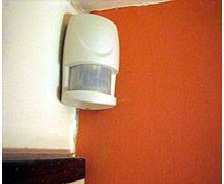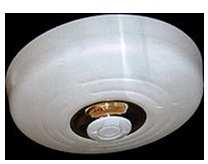A photoelectric sensor does not “directly” sense motion there is a narrow beam that won’t set off the sensor unless the beam is broken. Photoelectric sensors, along with dry contact switches, are a type of perimeter intrusion detector.
All of the other answers are valid types of motion detectors types. The content below on the different types of sensors is from Wikepedia: Indoor Sensors
These types of sensors are designed for indoor use. Outdoor use would not be advised due to false alarm vulnerability and weather durability.Passive infrared detectors

Passive Infrared Sensor
The passive infrared detector (PIR) is one of the most common detectors found in household and small business environments because it offers affordable and reliable functionality. The term passive means the detector is able to function without the need to generate and radiate its own energy (unlike ultrasonic and microwave volumetric intrusion detectors that are “active” in operation). PIRs are able to distinguish if an infrared emitting object is present by first learning the ambient temperature of the monitored space and then detecting a change in the temperature caused by the presence of an object. Using the principle of differentiation, which is a check of presence or nonpresence, PIRs verify if an intruder or object is actually there. Creating individual zones of detection where each zone comprises one or more layers can achieve differentiation. Between the zones there are areas of no sensitivity (dead zones) that are used by the sensor for comparison.
Ultrasonic detectors Using frequencies between 15 kHz and 75 kHz, these active detectors transmit ultrasonic sound waves that are inaudible to humans. The Doppler shift principle is the underlying method of operation, in which a change in frequency is detected due to object motion. This is caused when a moving object changes the frequency of sound waves around it. Two conditions must occur to successfully detect a Doppler shift event:
There must be motion of an object either towards or away from the receiver.
The motion of the object must cause a change in the ultrasonic frequency to the receiver relative to the transmitting frequency.
The ultrasonic detector operates by the transmitter emitting an ultrasonic signal into the area to be protected. The sound waves are reflected by solid objects (such as the surrounding floor, walls and ceiling) and then detected by the receiver. Because ultrasonic waves are transmitted through air, then hard-surfaced objects tend to reflect most of the ultrasonic energy, while soft surfaces tend to absorb most energy.
When the surfaces are stationary, the frequency of the waves detected by the receiver will be equal to the transmitted frequency. However, a change in frequency will occur as a result of the Doppler principle, when a person or object is moving towards or away from the detector. Such an event initiates an alarm signal. This technology is considered obsolete by many alarm professionals, and is not actively installed. Microwave detectors This device emits microwaves from a transmitter and detects any reflected microwaves or reduction in beam intensity using a receiver. The transmitter and receiver are usually combined inside a single housing (monostatic) for indoor applications, and separate housings (bistatic) for outdoor applications. To reduce false alarms this type of detector is usually combined with a passive infrared detector or “Dualtec” alarm.
Microwave detectors respond to a Doppler shift in the frequency of the reflected energy, by a phase shift, or by a sudden reduction of the level of received energy. Any of these effects may indicate motion of an intruder.
Photo-electric beams Photoelectric beam systems detect the presence of an intruder by transmitting visible or infrared light beams across an area, where these beams may be obstructed. To improve the detection surface area, the beams are often employed in stacks of two or more. However, if an intruder is aware of the technology’s presence, it can be avoided. The technology can be an effective long-range detection system, if installed in stacks of three or more where the transmitters and receivers are staggered to create a fence-like barrier. Systems are available for both internal and external applications. To prevent a clandestine attack using a secondary light source being used to hold the detector in a ‘sealed’ condition whilst an intruder passes through, most systems use and detect a modulated light source.
Glass break detectors The glass break detector may be used for internal perimeter building protection. When glass breaks it generates sound in a wide band of frequencies. These can range from infrasonic, which is below 20 hertz (Hz) and can not be heard by the human ear, through the audio band from 20 Hz to 20 kHz which humans can hear, right up to ultrasonic, which is above 20 kHz and again cannot be heard. Glass break acoustic detectors are mounted in close proximity to the glass panes and listen for sound frequencies associated with glass breaking. Seismic glass break detectors are different in that they are installed on the glass pane. When glass breaks it produces specific shock frequencies which travel through the glass and often through the window frame and the surrounding walls and ceiling. Typically, the most intense frequencies generated are between 3 and 5 kHz, depending on the type of glass and the presence of a plastic interlayer. Seismic glass break detectors “feel” these shock frequencies and in turn generate an alarm condition.
The more primitive detection method involves gluing a thin strip of conducting foil on the inside of the glass and putting low-power electrical current through it. Breaking the glass is practically guaranteed to tear the foil and break the circuit. Smoke, heat, and carbon monoxide detectors

Heat Detection System
Most systems may also be equipped with smoke, heat, and/or carbon monoxide detectors. These are also known as 24 hour zones (which are on at all times). Smoke detectors and heat detectors protect from the risk of fire and carbon monoxide detectors protect from the risk of carbon monoxide. Although an intruder alarm panel may also have these detectors connected, it may not meet all the local fire code requirements of a fire alarm system.
Other types of volumetric sensors could be:
Active Infrared Passive Infrared/Microware combined Radar Accoustical Sensor/Audio Vibration Sensor (seismic) Air Turbulence

